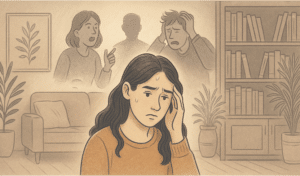Attention Deficit Hyperactivity Disorder (ADHD) is a neurodevelopment condition that is present in not only childhood, but also through adulthood, impacting focus, self-control, and emotional regulation. Despite a huge amount of research, it is still an often misunderstood condition. Many people are still unaware of the full scale of symptoms and the best ways to manage them. Through this article, we will look into what ADHD is, how it manifests, and practical strategies for managing ADHD in everyday life.
What Is ADHD?
ADHD affects how an individual processes information and reacts to external stimuli. It is commonly associated with three specific characteristics: inattention, hyperactivity, and impulsivity. These traits can show in different ways, depending on the individual and their environment.
According to the Centers for Disease Control and Prevention (CDC), ADHD is one of the most common neurodevelopmental conditions of childhood. However, it also affects millions of adults. It is now becoming clear that many adults with ADHD have lived with the condition for years, undiagnosed. They have never known or understood the reason behind their challenges with organization, time management, and emotional regulation.
Types of ADHD
ADHD is separated into three subtypes based on their main symptoms:
- Inattentive Presentation: Individuals with Inattentive type may struggle to sustain focus, follow instructions, or pay attention to details. They often appear disorganized or forgetful and may frequently lose common items like keys or their phone.
- Hyperactive-Impulsive Presentation: This type is marked by excessive fidgeting, constant talking, interrupting conversations, or an inability to sit still. Impulsivity can also lead to risk-taking behaviors.
- Combined Presentation: This is the most common form, where an individual shows a mix of both inattentive and hyperactive-impulsive symptoms.
Symptoms of ADHD
The symptoms of ADHD vary widely across all individuals and are on a spectrum that is not linear. They typically start in childhood, and while some children develop practical strategies to help, others may continue to experience challenges into adulthood. Hormonal changes (puberty, childbirth, menopause) can also exacerbate symptoms.
Inattentive symptoms:
- Difficulty paying attention to details
- Easily distracted by things going on around them
- Difficulty following through on tasks
- Often forgetful in daily activities
- Trouble prioritizing tasks or activities
Hyperactive-impulsive symptoms:
- Fidgeting with hands and/or feet
- Excessive talking
- Interrupting others’ conversations
- Difficulty waiting in line or taking turns
- Restlessness, especially in situations that require being still
Causes of ADHD
While the exact cause of ADHD remains unknown, research shows that it likely results from a combination of genetic and neurological factors.
- Genetics: Studies suggest that ADHD tends to run in families. Children with a parent or sibling who has ADHD are more likely to develop the disorder themselves. Many parents get diagnosed once their child(ren) has been diagnosed.
- Brain Structure and Function: Brain scan studies have shown that people with ADHD often have structural differences in areas of the brain that control attention and impulse control. Additionally, neurotransmitter imbalances, particularly with dopamine and norepinephrine, are believed to contribute to the condition.
ADHD in Adults
ADHD is often thought of as a childhood condition, but adults continue to experience its effects well into their adult lives, without always realising the reason. For adults, ADHD symptoms can show up differently. It may show up as poor time management and disorganization. Many adults with ADHD (diagnosed or not) struggle to hold down jobs or maintain friendships.
Adults with ADHD may also experience emotional symptoms such as mood swings, irritability, rejection sensitivity disorder (RSD) or low self-esteem. These issues often arise from the frustration of living with unmanaged symptoms or lack of diagnosis. It can affect personal and professional success.
For women in particular, hormonal changes can exacerbate symptoms. Post-childbirth and menopause are particular points in their life where they may struggle the most. Women are also regularly diagnosed with anxiety and depression for years before realizing it may be undiagnosed ADHD. Understanding why these changes happen can make a huge difference.
Diagnosis of ADHD
Diagnosing ADHD is by assessment from a healthcare professional. There is no single test to diagnose the condition; instead, it is concluded through a combination of patient interviews, behavior assessments, and medical history.
For children, input from teachers and parents is critical, as they can provide insights into the child’s behavior in various settings. Presentation must be seen in at least two separate settings (home, school and/or clubs/activites). Healthcare professionals may use standardized rating scales and behavioral checklists to assess the severity of symptoms.
For adults, diagnosis can be more difficult. Hence why many adults may not have been diagnosed as children. This can lead them to feel their struggles are personality traits rather than a medical condition. An ADHD diagnosis in adults often involves an assessment of childhood behavior patterns, along with current struggles in areas like work, relationships, and time management.
How to Manage ADHD
ADHD is a lifelong condition, however, with the correct treatment, individuals can effectively manage their symptoms and lead successful lives. The most common treatment options include medication, behavioral therapy (CBT), lifestyle changes, and practical strategies.
1. Medications
Medications such as Ritalin and Adderall, help increase dopamine and norepinephrine levels in the brain. They can help improve focus, attention, and impulse control.
There are also non-stimulant medications for those who do not respond well to stimulants or have contraindications. These medications work by modifying neurotransmitters in the brain without the stimulating effects.
2. Behavioral Therapy
Cognitive-behavioral therapy (CBT) is a popular therapy for managing ADHD symptoms, especially in adults. CBT helps individuals develop practical coping strategies for managing time, organizing tasks, and can also help improve emotional regulation.
For children, behavior adaptation techniques—such as setting clear expectations, providing a structured routine, and using positive reinforcement—can be highly effective.
3. Lifestyle Changes
Some lifestyle changes can greatly help the effectiveness of ADHD treatments:
- Exercise: Physical activity has been shown to increase dopamine levels, improving attention and mood.
- Healthy Diet: A diet rich in protein, omega-3 fatty acids, and low in sugar can help manage symptoms. There are also some studies which show that a Keto diet can have a positive impact on ADHD symptoms.
- Sleep: Many individuals with ADHD struggle with sleep, having good sleep hygiene can improve focus and overall well-being. Melatonin can also be used to help aid sleep if an individual is still struggling.
4. Support Systems
Having a great support network is key to managing ADHD, especially for adults who may have struggled for years without a diagnosis. This includes:
- Support groups: Finding others (online or in-person) who have or understand ADHD can provide emotional support and practical advice.
- Coaching: ADHD coaches specialize in helping individuals develop time-management skills, stay organized, and set realistic goals.
Myths About ADHD
Despite the growing awareness around ADHD, there are still several myths that persist:
- Myth 1: ADHD is just an excuse for someone being lazy.
- Fact: ADHD is a real neurodevelopmental condition that affects a brain’s executive functions, making it harder to focus and complete tasks.
- Myth 2: ADHD only affects children.
- Fact: ADHD is a lifelong condition but can be helped with developing coping strategies and skills. Many adults live with undiagnosed ADHD, leading to challenges in work and relationships.
- Myth 3: ADHD is caused by bad parenting.
- Fact: Parenting styles do not cause ADHD. Whilst it does tend to run in families, there is no direct correlation between a style of parenting and ADHD. However, understanding ADHD and developing practical strategies to help as a parent, will help children with ADHD.
Conclusion
ADHD is a complex, lifelong condition that affects millions of people worldwide. While it presents unique and individual challenges, early diagnosis and a comprehensive treatment plan can help individuals lead fulfilling, productive lives. By staying informed, embracing support systems, and seeking professional help when needed, people with ADHD can effectively manage their symptoms and thrive.







